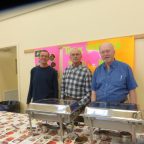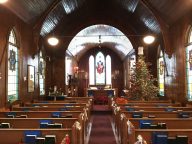Into the Mystery (February 11, 2018)
What a weird little story we read this morning. What do we do with it? How are we to understand it?
Let’s begin with the mountain. In the Bible, high mountains are places of both mystery and revelation. Important things happen on high mountains—Noah’s ark came to rest on a high mountain; Moses received the Ten Commandments on a high mountain; Abraham almost sacrificed his son Isaac on a high mountain.
Today, Jesus hikes up a high mountain with Peter, James and John. At the top of the mountain, he is transfigured. He undergoes a metamorphosis. His clothes became a blazing white. Two heroes of the faith, Moses and Elijah, appear on either side. A voice from the cloud which envelopes them singles out Jesus as the one they should heed. Peter is so awestruck that he suggests they should build some structures to commemorate the event.
At the end, after it’s all over, Jesus asks the disciples to keep it all a secret—until after the resurrection.
What are we to make of this transfiguration story? Strange things are happening here. Heroes of the faith come and go. Wild wonders abound. Jesus glows.
Is it all a dream? Did it really happen? Is this a foreshadowing of the resurrection?
I don’t know. Mark’s way of telling this story is so bare, so terse. There are no extraneous details. There’s no theological commentary He just narrates the story.
Now I can tell you what the details mean:
- mountains are high places, halfway between earth and heaven, a place to meet with God;
- Jesus’ dazzling white clothes are a symbol of light gleaming in the world;
- Moses and Elijah are the two holy men of Israel; when Jesus stands in their midst, he is a new holy man, a new sign of God’s presence with God’s people;
- the cloud that envelopes them is a strong symbol for God in the Bible—the cloud both reveals God and hides God;
- the voice from the cloud repeats the words we first heard at Jesus’ baptism. “This is my Son, whom I love.” But this time the voice adds something else: “Listen to him!”
Those are the details. And it’s helpful to know those details.
But at its heart, this story is Mystery. With a capital M. Mystery.
Our society doesn’t much like mystery. It’s a little uncomfortable. We like to be able to solve things, to explain stuff—and so we think of mystery as a puzzle we haven’t solved yet. Once we figure it out, there will be no more mystery.
It’s like a mystery novel for us. We read and try to figure out whodunnit. We play along with the author, we look for clues and sift through them, and the whole goal is to figure it out.
But there’s nothing to solve here.
So let me suggest this morning that “Mystery” is so much bigger than that. When we are in the presence of Mystery, we learn to see our lives in a whole new way.
It’s like the birth of a baby. I can explain scientifically how a baby is conceived and born and how it grows. I could even bring pictures and charts and graphs. Some of you may have seen ultrasound pictures of your children or grandchildren in utero.
But as any parent knows, none of that counts when the baby is born. It’s good to know the science of how a fetus develops, but that’s nothing compared with the wonderful mystery that suddenly enters our lives when a baby is born. When that happens, we enter the world of wonder and awe.
I still remember the moment I held my children in my arms. I had no words. My heart was suffused with wonder. My whole life was bathed in a new aura of grace. Everything had changed. Everything was new. Life was different.
I suspect most of you know what that’s like. It’s an experience beyond words.
This story in Mark is like that. We witness this mysterious transfiguration, and life is made different. Life is changed.
I don’t know if you noticed it or not, but the story begins, “After six days, Jesus took Peter, James and John …” So we look back in Mark’s story. Six days earlier, Jesus had told them for the first time, “If you want to be my disciples, you have to take up your cross and follow me.”
It’s a hard word. If you want to be a disciple, do what Jesus does. Follow where Jesus leads. Touch people as Jesus touched them. Welcome people as Jesus embraced them. Serve. Give yourselves away for the sake of the world. Take up your cross and follow.
It’s a hard word.
And now, the disciples get this vision of the high mountain. And what comes through in this story is the absolute centrality of Jesus. For a moment, we get a glimpse into the heart of God as the voice whispers in sheer delight, “This is my boy, my precious and cherished boy. Y’all listen to him now.” It’s a moment of tender holiness.
Pay attention to Jesus. Listen to him. Follow him. As you do so, Jesus will show you with life, real life, looks like. Jesus is the key to abundant life. If you watch him carefully, you will know what it means to be fully alive. You will know what it is to live with grace. You will know what it is to live with compassion and hope.
Jesus helps us see that life is shot through with the love and glory of God. Here on the top of the high mountain, Jesus becomes a beacon in the darkness. Jesus will show us what it is to live fully in the presence of God in every moment of our lives.
Listen to him. And as we listen, we will find that Jesus doesn’t explain the secrets of the universe. Jesus doesn’t tell us the meaning of life. Jesus doesn’t give us a set of rules to make a better life. Jesus doesn’t tell us that pain and sorrow and evil will be wiped out.
Jesus shows us again and again that no matter what happens in life, God is present. God is with us. God loves us.
Jesus reveals a relationship.
And there, I think, you have the centre of Christian faith. Our faith is about a relationship with God, which ebbs and flows, which changes and grows, which moves through highs and lows.
As God has claimed Jesus, so God claims us at our baptism, “You are my daughter. You are my son. I will not let you go. Not ever.”
It’s the promise that God is with us. It’s the promise that God is for us. It’s the promise that God is at work in our lives, in our words, in our actions so that we may show God to the world. Just as Jesus is the Light of the World, so we bear the light of Christ in our hands and hearts as we move into the world.
God is with us. And we, as we muddle through our daily lives, we try to be with God.
Thanks be to God.
Rev. Dr. Yme Woensdregt
February 11, 2018 (Last Sunday after Epiphany, Sunday of the Transfiguration)
Mark 9: 2–9
2 Kings 2: 1–20
2 Corinthians 4: 3–6







